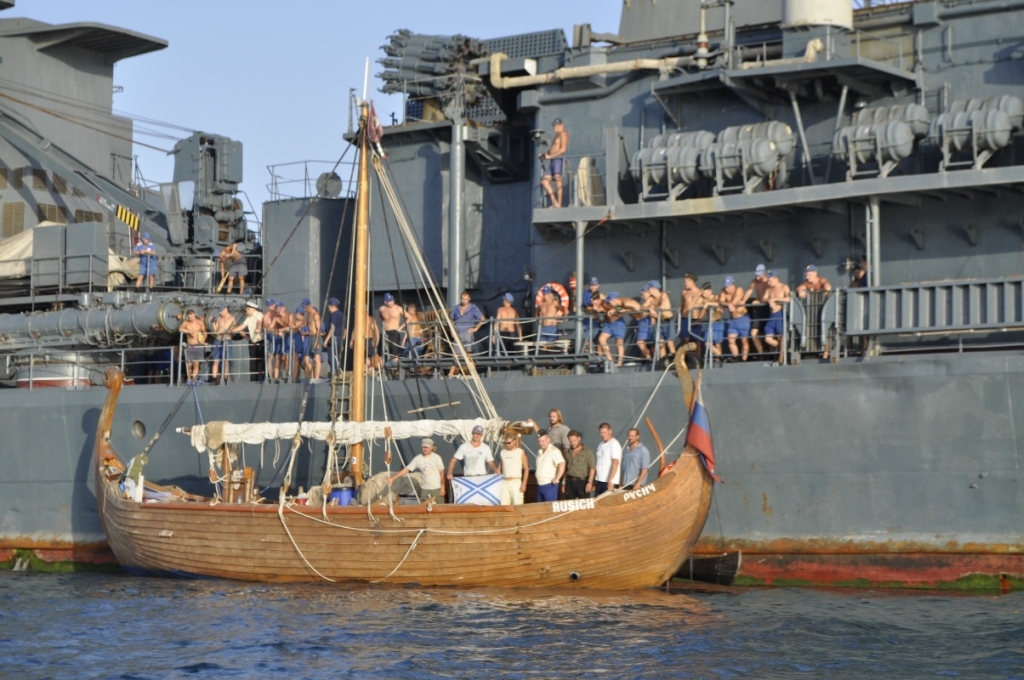
Sinbads of Kazakhstan
The Sinelniks team request assistance from the Russian Military Forces to sail through the pirate region. The destroyer Admiral Levchenko escorted the Rusich through the Horn of Africa for three days. (Photo: Eleanor Wilks)
“There’s nothing better to behold
Than for friends to roam around the world
And close friends the hardship do not fear
All the roads they’re sure to find dear.
All of them we always find so dear.
Our carpet is the field of flowers.
Giant pines – they form the walls of ours.
Our roof – the vast blue sky up there
Our joy – one destiny to share!
Yes, to have one destiny to share.”
From Soviet cartoon The Bremen Musicians
(musical version based on the Brothers Grimm tale)
Sinbad’s spirit of adventure will make you sail seas and oceans, cross deserts and climb mountain peaks. On foot, on motorcycles or on boat, twin brothers Sinelnik roam the world, and keep coming up with more adventurous travels. They have just returned from a 2½-year sail from Russia to Australia that they have accomplished on their Viking boat replica, sailing 17 seas and three oceans, circumnavigating 26,000 kilometers on the world’s waters.
Twin brothers Sergey and Alexander Sinelnik dreamt of traveling to faraway lands since childhood. As teenagers, the brothers always packed snacks and went camping on the banks of the Ural River in their home city of Uralsk (in Kazakhstan). In the boys’ minds, they were exploring the unknown lands, crossing barriers and facing challenges. They dreamt that one day they would head off into a real adventure.
Rusich: A Vessel of Dreams

Now, the Sinelnik brothers are well-known in their hometown and abroad for their travels. One day, people would read in the newspaper that the Sinelniks were the first to drive around the world on Ural motorcycles, covering 75,000 kilometers. Another day, the twins covered 1,000 kilometres on foot through the Western Sahara Desert. Later, they were the first to drive on IZH motorcycles through the seven largest deserts of the Earth without any escort.
After conquering deserts, the Sinelniks challenged themselves to climb the world’s seven highest mountain peaks. They have already climbed Kilimanjaro (5,895 ?), Kosciuszko ( 2,228 ?) and Elbrus (5,642 ?). These are just a few examples of their many extraordinary travels.

When it came to exploring the world’s waters, the brothers decided to build their own boat. The Sinelniks wanted to sail a boat that would tell a beautiful story to the world.
They decided to build a 10th-century rook, a Viking and East Slav replica. In the 10th to 13th centuries, Vikings and Slavs occupied Northern and Eastern Europe. They shared part of the land and culture. Together, they built vessels and committed predatory raids on Byzantium.
Like Vikings and Slavs, the Sinelniks built their coast-dweller of hewn trunks of pine and oak, with oars and square sails. Like Vikings and Slavs who once gave Russia its name, the Sinelniks dubbed their boat Rusich. Built in the Russian city of Petrozavodsk in 2006, the twin brothers’ rook was 15-meters-long, four-meters-wide, and had a capacity of 11 people.
The twin brothers planned their first expedition as a historical experiment: to sail their Viking boat as if they lived in the 10th century. They assembled a team of researchers and chose to sail the ancient Volga trade route. The route went from Northern Russia to Persia (Iran) via the Volga River where it connected with The Great Silk Road.
Once their boat was ready, the Sinelniks’ team set sail and reached the Iranian border. At the time, social unrest in Iran made it dangerous to cross the border, so they returned home.

This trip taught the brothers that they could sail in a 10th-century boat, wearing Viking garments and using Viking tools on the river; but to navigate the world’s waters, they would still need modern technologies like GPS (Global Positioning System).
Soon after returning home, the brothers announced that they would sail again – this time to Australia. Their family and friends were worried: the wooden rook is a coast-dweller, and is not meant to sail high seas. But the Sinelniks were determined.
It took them four years to gather a new team and to raise funds. Sinelniks’ team members were people from all walks of life and different countries, who dreamed of sailing the world. Some of the crew members had never sailed before; some had never even seen an ocean. The crew helped finance the voyage. Boris Filatov, a Ukrainian journalist and lawyer, organized different fundraisings to help Rusich lift anchor and sail away.
To Sergey’s disappointment, his twin brother Alexander could not start the journey with him. He had a contract job in Ukraine – he was painting a cathedral in the city of Dnepropetrovsk. But Alexander would eventually join the Rusich crew in their sail around Australia.

Life at Sea
At last, after lengthy preparations, Sergey Sinelnik raised Rusich‘s sails on the Volga River. It was August 10, 2010. The Volga River took the boat to the Black Sea. Then, Rusich sailed the Marmara Sea, the Aegean Sea and the Mediterranean Sea.
The team lived on deck and slept on planks. They had GPS, maps and a small motor that was used when passing through steep channels; but most of the time, they sailed by catching winds and monsoons.
Sergey Sinelnik taught every team member how to operate the ship and how to sail. Day and night, each team member carried out a four-hour shift on the rook. The boat had one designated cook. Mostly, the crew ate canned and imperishable food; sometimes, they bought fresh vegetables at ports. Their shower represented a barrel with holes that came with a rule: wash yourself with sea water and rinse with less than two litres of fresh water.

After sailing 7,400 kilometres, Rusich reached Djibouti, a dangerous pirate region in the Horn of Africa. Sinelniks’ friend, the famous Russian traveler Fyodor Konyukhov, advised them to take a military escort while passing Somalia.
Dangerous situation in Djibouti, piracy threats and uncertainty – the crew was falling apart. Six of them left the ship.
Not knowing what to do, Sergey Sinelnik – with help from the Russian Embassy in Djibouti – sent a telegram to Russian Forces’ headquarters asking for a military escort. While waiting for the support to arrive, the Rusich crew received some help and protection from NATO soldiers, who provided them with food and water.
The escort came in a week. A large destroyer – the Admiral Levchenko with 400 sailors on board – was ready to accompany the rook. The destroyer was part of the Russian operations to combat piracy off the Somalia coast. The ship escorted them for three days.
“Imagine such a big high-speed ship traveling with our slow dragging boat for three days, in waters where every small fishing boat could be a pirate boat,” Sergey Sinelnik remembers.
When Rusich safely reached the Sultanate of Oman, the team could not obtain visas for a long time. They had to leave the boat in Salalah and return home. After five months, Sergey Sinelnik returned to Oman with a new team. The only problem was that their pine vessel had dried up under the scorching sun. The flatboat’s planks drifted apart, and it was sinking into the water. The crew had to rinse the rook with 20,000 tons of sea water before they could sail it again.
On May 1, 2011, Rusich sailed into the Indian Ocean. After sailing for 6,000 kilometres, it reached Thailand. In the shipyard there, the crew replaced 12 planks and made a few repairs. Rusich resumed course to the shores of Australia.
In less than six weeks, the sailors reached Darwin where the media and the public were excited to welcome them. By that time, Alexander Sinelnik finished painting the cathedral and rejoined his brother on their dream vessel.
“I am a Celt. This adventure is my heritage.”
Meanwhile, Andy Gray – an old friend of the Sinelniks – was waiting for the Viking boat to arrive at its next destination in Brisbane. Like the Sinelniks, Gray is also a craftsman and an artist. He designs jewelry, sculpts in clay, carves in wood, creates works from leather and metal. Passion for art and travel allowed him to stay friends with the Sinelniks for nine years. Gray was about to join the Rusich expedition.
But Gray’s intention to sail around Australia made his family and friends uncomfortable. They well knew the waters of Australia and the dangers they represented.
“I had a lot of people worried and expressing their concerns of the dangers of this voyage, but I knew this is a once in a lifetime opportunity that should not be missed,” Gray says. “I am a Celt. This adventure is my heritage.”
Gray and two other Australians boarded the rook in Brisbane, but only Gray was brave enough to sail with the Sinelniks through the Bass Strait to Tasmania.
The Bass Strait is a sea strait that separates Tasmania from the south of the Australian mainland. Like the Bermuda Triangle, the strait is known as a Devourer of Ships – a treacherous combination of wind and sea conditions, semi-submerged rocks and reefs that wrecked many vessels, small and large. Over the past 200 years, more than 400 ships sank in these treacherous reefs.
Together with the brothers Sinelnik, Gray sailed around Australia, through the Arafura, the Coral, the Tasman seas, passing by the Antarctic and the Pacific oceans. Movement along the east coast of Australia required great skill, but the Sinelniks and their team made their way, rounding their trip to 26,000 kilometres. The ancient flat-bottomed Rusich sailed 17 seas and crossed three oceans.
The Rusich adventure changed Gray’s life. The Australian says he learned that language has no barriers and humour is universal; that time at sea broadens the mind and nothing beats fresh fish, eaten raw off the deck. But most importantly, the journey brought him lifelong friends.
“I felt welcomed and a part of a family,” Gray says. “I don’t know if it’s the communist influence or that they are orthodox, but the attitude towards sharing is much more in depth than I have ever seen or experienced. It was quite refreshing to see and be a part of.”

Gray says he is honoured and proud to call the Sinelniks his friends, and trusts them with his life: “They are true adventurers and explorers. They have so much respect for everyone and everything. I am humbled by their attitude towards life.”
What was the biggest challenge during their voyage? Sergey Sinelnik answers: people.
“One of the main difficulties were not winds and storms, but compatibility of different personalities in the team. Members of the team didn’t know each other. Some of them had never been to sea. Some got seasick and were disappointed that they spent money on the journey. But from the very beginning, I would tell them: if you are seeking pleasure, you have to take a cruise!”
What Dreams May Come
The brothers agree they have a much harder time adjusting to life on land than at sea. The Sinelniks say every time they return home from their travels, they become disenchanted with reality, finding that people are obsessed with buying things, taking credits, and then buying more. It’s easy to lose a dream in such a world, according to the Sinelniks. Sergey observes: “There was a Soviet song with the lyrics: ‘Don’t let the heart stop beating.’ I think it is very important to keep the fire burning inside your heart. And more important is to carry it into adult life.”
Alexander Sinelnik says since childhood, their dreams helped them at work and in life. “Our dreams do not give us rest, and our imagination is always illuminating a new path. This gives us strength in difficult life problems.”
“I am happy to have a twin brother,” Sergey says. “When it gets hard in life – we meet and we dream, and the fire keeps burning.”
The twins plan a special anthropological art project – to create sculptures of major world cultures and peoples. The brothers want their project to celebrate and cherish the beauty of the world’s diversity.
Also, the Sinelniks plan to rebuild Rusich, so that next time, they can sail the world with their families. Both brothers are happily married with children.
At the end of the interview, the twin brothers asked for the inland waterways map of Canada. So don’t be surprised if one day, you see the Viking boat Rusich on the Rideau Canal!













